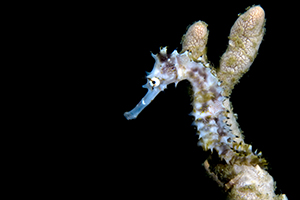Seahorses: There are 49 different species of seahorses ...
 They smallest species of seahorses are called dwarf seahorses or pygmy seahorses.
They smallest species of seahorses are called dwarf seahorses or pygmy seahorses.
Did you know? ...
+ Anemonefish+ Frogfish
+ Lionfish
+ Mandarinfish
+ Moray eels
+ Rhinopias
+ Ghost pipefish
+ Sea cows
+ Seahorses
Seahorses belong, together with the pipefish, to the family of Syngnathidae. The fish of this family are characterized in the fact that the male becomes pregnant. After an intense courtship dance, which can last up to two days, the female puts her eggs in the special brood pouch of the male, and just after they are fertilized with his sperm. Two to four weeks later, the tiny seahorses leave the pouch and start their own lives.
All seahorses generally live in warmer waters. But thanks to the warm Gulf Stream, two species (namely the short snout and the long snout seahorse) can also be found in our colder waters like the North Sea and in the Eastern Scheldt.
Although seahorses do not really look like fish, they are fish. But they have no scales, making the hippocampus actually has both, an internal and an external skeleton. As a result, they are for many other animals too hard to eat and so difficult to digest. Besides of the sea crabs, the hippocampus has thus few enemies. Seahorses itself have no teeth and no stomach. This is the reason they have to eat constantly.
All seahorses belong to the genus Hippocampus, coming from the Ancient Greek words for horse (hippos) and sea monster (campus). The size of the seahorses is depending on the species. They smallest species have a maximum size of 2.4 cm! Because of their extremely small size they are called dwarf seahorses or pygmy seahorses. Contemporary, there are nine species of pygmy seahorses known and most species were only discovered in recent years.
 Denise pygmy seahorse
Denise pygmy seahorse
 Seahorses anchor by their tail
Seahorses anchor by their tail
 Thorny seahorse
Thorny seahorse
Most species of seahorses can be found in slushy or sandy areas. Some however, lives preferably between corals and sponges.
They usually stay for a long time at the same location, and during their entire life they remain with the same partner.
The eyes can rotate independently of each other, and with their long retractable prehensile tail they are usually anchored to sticks, coral or algae.
The most famous seahorse is probably the hippocampus bargibanti pygmy seahorse. They are usually found at greater depths, between 25 and 35 meters. But we have already found bargibanti seahorses at a depth of less than ten meters! They only live on the gorgonian corals of the genus Muricella, where they perfectly take the shape and color (red or yellow) of the fan they are living on. At night the polyps of the coral Muricella usually are open and it looks so much better on the photo than on a picture taken during the day, when the polyps are usually closed.
In contrast, the Pontohi pygmy seahorse lives relatively shallow. Most of those animals are found between 7 to 14 meters depth. We distinguish a brown, yellow and white variant with a maximum size of 14mm! So they are much smaller and they are also much more mobile than the Bargibanti pygmy seahorse. So shooting a Pontohi pygmy seahorse takes a lot of patience.
To photograph seahorses: take your time! Seahorses also have a habit to turn their back when they think they are in danger or in case of trouble. Some species are going to lie down on the sand and are playing dead. Not really the ideal position to shoot beautiful pictures.
But when they get used to you and your presence you probably will be rewarded for your patience!
Species of pygmy seahorses :
The most famous seahorse is probably the hippocampus bargibanti pygmy seahorse. They are usually found at greater depths, between 25 and 35 meters. But we have already found bargibanti seahorses at a depth of less than ten meters! They only live on the gorgonian corals of the genus Muricella, where they perfectly take the shape and color (red or yellow) of the fan they are living on. At night the polyps of the coral Muricella usually are open and it looks so much better on the photo than on a picture taken during the day, when the polyps are usually closed.
In contrast, the Pontohi pygmy seahorse lives relatively shallow. Most of those animals are found between 7 to 14 meters depth. We distinguish a brown, yellow and white variant with a maximum size of 14mm! So they are much smaller and they are also much more mobile than the Bargibanti pygmy seahorse. So shooting a Pontohi pygmy seahorse takes a lot of patience.
To photograph seahorses: take your time! Seahorses also have a habit to turn their back when they think they are in danger or in case of trouble. Some species are going to lie down on the sand and are playing dead. Not really the ideal position to shoot beautiful pictures.
But when they get used to you and your presence you probably will be rewarded for your patience!
Species of pygmy seahorses :
Species of seahorses :
 Hippocampus bargibanti
Hippocampus bargibanti
 Hippocampus denise
Hippocampus denise
 Hippocampus pontohi
Hippocampus pontohi
 Hippocampus kuda
Hippocampus kuda
 Hippocampus jayakari
Hippocampus jayakari
 Hippocampus histrix
Hippocampus histrix